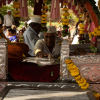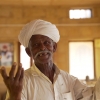Madhavi Mudgal is one of the acclaimed Odissi dancers today. Born in 1951, and growing up in a culturally inclined family in Delhi, Mudgal gravitated to dance and music from a very early age. She was trained in Bharatanatyam and Kathak but after watching an Odissi performance by Sanjukta Panigrahi and Kumkum Mohanty in Delhi, she was instantly drawn to the beauty and lyricism of the dance and began to train under Harekrishna Bahera. Later, she became the disciple of the legendary Odissi guru Kelucharan Mohapatra, and under him she blossomed into an exemplary dancer. She has performed on innumerable stages nationally and internationally. She has been at the forefront of steering the nascent classical dance form of Odissi to greater heights and bourgeoning its popularity by conducting workshops and concerts. Her choreographies received critical acclaim in reputed dance festivals across India and abroad. She has been honoured with the Padma Shri, Sanskrit Award, Sangeet Natak Akademi Award, 1996, Grande Medaille de la illa by Government of France, Central Sangeet Natak Akademi Award, Delhi State Parishad Samman, and she was also conferred with the title of Nritya Choodamani in 2006.
Following is an edited transcript of the second segment of the conversation with Madhavi Mudgal conducted by Madhur Gupta in Delhi, 2018.
Madhur Gupta (MG): Madhaviji, why is the guru‒shishya (disciple) tradition so important, and what do you think about institutionalised teaching?
Madhavi Mudgal (MM): In the current times, it is difficult for any guru to have somebody staying with them. For one thing, the houses are small, and also nobody is supporting the gurus. Earlier the disciples stayed with the guru and were taught for free, and they did house chores and other kinds of seva (service) for the guru. We can’t expect that of anybody now. And it is not possible also. Times have changed. So, at an institution like the Gandharva Madvidyalaya, we see the students’ capability and see if they have that possibility of blossoming into soloists, then we pick them up and give them special training. So, there is that one-to-one attention given within an institutionalised frame. If you see all the gurus—Vempati sir (Vempati Chinnasatyam), Guruji (Kelucharan Mohapatra)—they all had to establish an institute. So that is the only way now. But you have to have a guru giving you direct input. But the gurus must also surrender themselves completely, which is not happening.
MG: What do you mean when you say that the gurus have to surrender themselves?
MM: The student has to have complete faith in their guru. When they come to learn, nowadays the attitude is of questioning every single thing. My generation of teachers—I don’t call myself a guru—we do teach and encourage such questioning, but not when you begin your learning. When will I learn this or that? What is this? Trust the guru, and they will take you to a stage where you can ask those questions.
MG: So what are the key teachings which you have taken from your guru, technique-wise or even in life?
MM: Guruji was a perfectionist in anything he did, whether it was building his house brick by brick or doing make-up for his students or tying their dhoti or their ghungroos, every single aspect was dealt with perfectly. Decorating the stage, seeing to the musicians—everything he did. He was a perfectionist. So, I think, I have imbibed that. Whatever you take on, especially in terms of the stage, you have to think of everything and do it yourself. It is easy to instruct, you know, but then it won’t happen the way you want it to. You have to either do it yourself or actually be there and get it done. So that thing, I think, I have imbibed from Guruji—that everything has to be looked into, every detail has to be cared for it to result in something nice.
MG: What is your comment on the statement that Odissi is lurking towards more folkish elements and its classicism is being sidelined?
MM: Yes, what I feel is that, it may or may not be true, when Guruji and his generation of gurus were reviving this form—it was not even known as Odissi at that time—they were trying to cull in elements, the classical elements from our literature, from the literary texts, from classical sculpture, from classical music, and making the form complete as we have it today, as we have inherited it. But now I find that it is going back to more folk roots. Of course, you can look into folk roots for inspiration to imbibe in your classical way, but you can’t copy folk elements in your dance. It is becoming more folkish.
One very big example is that the gotipuas (young boys dressed as in female costume and dancing in praise of Krishna) becoming very sophisticated Odissi dancers, and Odissi dancers are becoming more folkish or gotipua-like.
MG: Why do you think this shift is happening?
MM: I think one reason is more of this going back to your roots, which is fine, because it is more Odiakaran, I would say, like in the South it is more, Bharatanatyam is more Tamil, it was all Telugu padams, they are now going more into even older texts, Sangam literature and all. So that kind of trend is fine, but that should be done in a very sophisticated manner. So aesthetics, personal drishti (here it means judgment) is what is required.
MG: So, emerging from the point of view of drishti, what do you think is the drishti which the government has towards classical arts—as we were discussing that the classical arts which we see nowadays were revived in the 50s with this feeling of nationalism? Then it continued on in the 60s, 70s and 80s when India wanted to create an image of itself, so cultural policy was a very strongly looked into. Where do you find classical arts now and who is pushing it, what is the motivation which will push it further? Is it just the corporates or, I mean, going forward how will classical arts survive?
MM: Yes, it is difficult because we can’t expect the government to do everything. This support has to come from the society—their interest. The corporate world has a lot of responsibility because they are the ones who have money now. But you need that drishti to support the right things, to create the right atmosphere for it to prosper in a meaningful way. So, policy is needed, and we should not expect the government to do everything, also because once they do it, it is not in the hands of artists or with that drishti. Maybe there are some bureaucrats who have that drishti, but generally it is lacking. And I don’t think in the arts you can bring in a democratic process. If some outstanding artistes have to go abroad, they should not wait for four years for clearance or something. Excellence should be looked at, and not just when your turn in the queue comes, and, I think, that is a big problem. And then we have a lot of mediocrity.
MG: So, talking of challenges, what is your comment when I say that being a rasika (connoisseur) of a classical art and learning a classical art can only be the prerogative of the elite?
MM: No, no, I think, when you sing in a small village in Bengal or Maharashtra, there is a big audience who know things and are learned. They are learned in the arts. So, what does it mean? It is not the rich few who can be the rasikas. Elite in sensitivity, I would say. People with sensitivity. Classical arts are not as popular as the popular arts. For example, Bhimsen Joshiji was not as popular as Lata Mangeshkar. It is not to say that Lata Mangeshkar is not a great artist, but she has a different appeal. So classical arts cannot have that mass appeal, it has to be a cultivated audience, and rasikas also have to put in an effort. In today’s culture, everything is thrown at them, they have to make no effort at learning or going deeper. So that is why you have what you have.
MG: What is the practical advice you would like to give to the younger generation of performers of the genre?
MM: I am nobody to advise anybody, but if I have to say something to the young people, it is that they have to pursue it with sincerity over a long period of time and not seek results immediately. This is something that takes time, it just takes time. You may have the best of talent, you still need to hone it, you still need to cultivate it, you still need to be at it to reach a certain level. I think it takes about twelve to fifteen years of initial learning before you realise what you are really learning. And then if you are lucky to find a good guru, you can branch out on your own.













